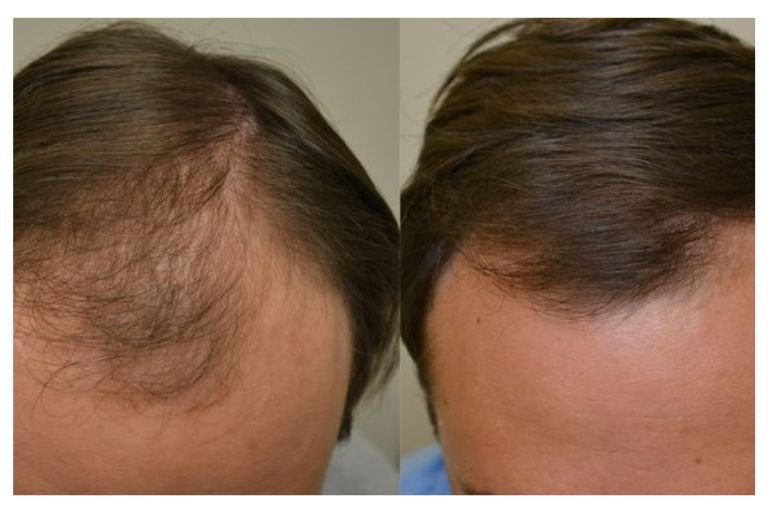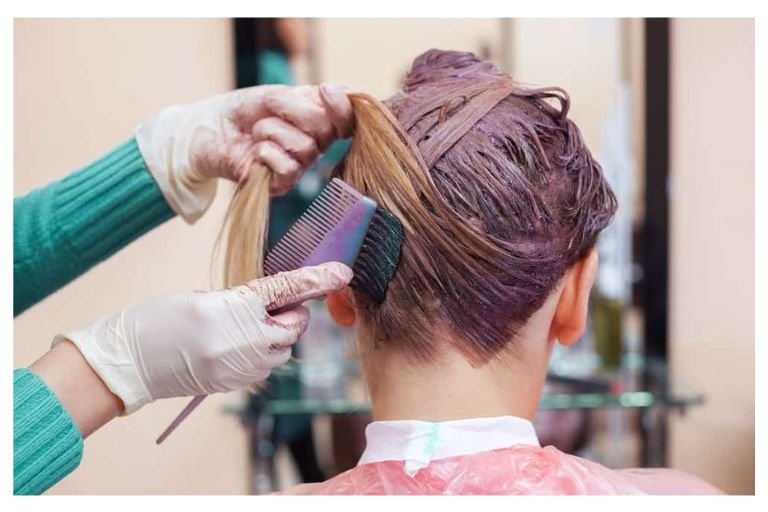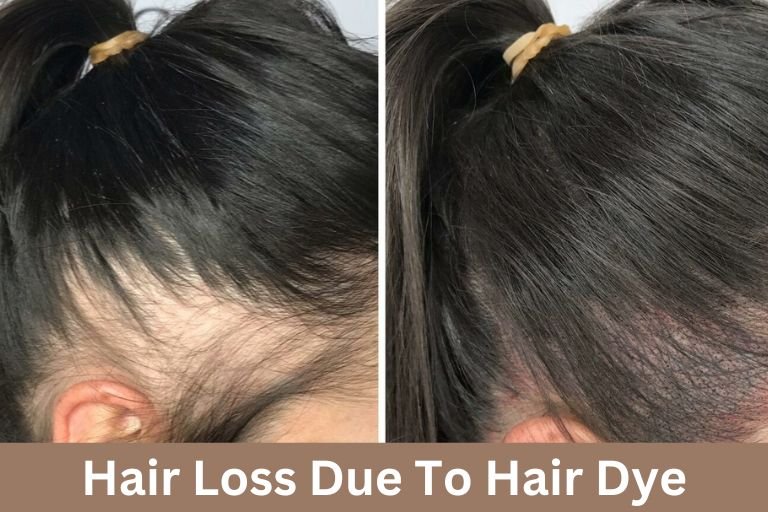When you dye your hair often, you may notice hair falling out. This can be a concern for many people. Thin hair and a more visible scalp may make you wonder if your hair will grow back. Hair loss due to hair dye: Will it grow back? This article looks at how dyeing your hair can affect hair health; if it is lost, hair will regrow.
Why Am I Losing Hair After Coloring It?
Hair loss after coloring can be upsetting, affecting your look and feel. The chemicals in hair dye can weaken your hair, making it more likely to break and become thin. This can worsen if you color your hair often or don’t take care of it properly after coloring, like using harsh shampoos or not conditioning.
It is important to balance getting the desired color and keeping your hair healthy. Taking good care of your hair after coloring is essential to prevent hair loss. Deep conditioning treatments, being gentle when styling, and avoiding too much heat can strengthen your hair and reduce breakage.
Getting advice from a professional hairstylist on the right products and techniques for colored hair can help maintain your color and keep your hair healthy. By nourishing and protecting your colored hair, you can encourage healthier growth and feel more confident in your hairstyle.

Damage To The Strands
Chemicals in hair dye can harm your hair by weakening it and making it more likely to break and fall out. Ammonia and hydrogen peroxide in dye can damage the structure of your hair, leading to brittle strands that easily break.
Taking care of your hair before and after dyeing is important to prevent damage. Products that restore proteins, moisture, and strength are key to protecting your hair from harm. Following a good care routine can keep your hair healthy and strong even after coloring it multiple times.
How Do You Handle Hair Breakage From A Dye Job?
To prevent hair breakage from coloring your hair, try these tips:
Take A Break From Hair Dyes
Taking a break from hair dyes can help make your hair healthier. Bleached and light-colored hair often needs frequent touch-ups, which can cause damage and make it brittle. Returning to your natural hair color can help your hair recover and become stronger.
Styling tools like straighteners or curling wands can also help your hair grow healthier. Stopping the constant coloring and processing of your hair gives it a chance to repair itself naturally. Embracing your natural color reduces damage and lets you appreciate your original hue. Using less heat styling tools can prevent more damage and breakage, making your hair strong and healthy.
Use Gentle Hair Products
Simplifying hair care is important for healthy and beautiful hair. Using gentle products with protein can improve hair health. Protein treatments repair damage and strengthen hair. Using a daily conditioner and leave-in cream with protein helps maintain hair health.
Hydration is also important for vibrant hair. Look for products with moisturizing ingredients like coconut oil and argan oil. Deep conditioning with a protein mask can boost moisture levels in hair. Prioritizing protein and moisture in your hair care routine produces strong, nourished, and manageable hair.
Minimize Hair Manipulation
When taking care of your hair, doing less is often better. Combing and brushing too much can make your hair break easily, especially if it’s dry and fragile. Instead of combing or brushing a lot, try using your fingers to detangle your hair in the shower with a mask or conditioner.
This can help reduce damage and keep your hair healthy. Detangling with your fingers when your hair is wet makes it easier to remove knots without causing harm to your hair. It also helps spread products evenly in your hair, ensuring each strand gets the moisture it needs to be strong. Regularly using this gentle method will make your hair look and feel better.
Get A Trim
Getting a trim is more than just a regular hair task. It can transform your hair by removing damaged ends and giving it a fresh start. This simple act can make your hair healthier and more vibrant. Regular trims can improve the texture and manageability of your hair by removing excess weight and creating layers.
Stylists suggest getting trims every 6-8 weeks to maintain your haircut’s shape and prevent split ends. Remember, getting a trim is investing in your hair’s long-term health and beauty.
Can Hair Dye Cause Hair Thinning In The Long Run?
Hair dye can make your hair thinner over time because the chemicals in the dye can weaken and break your hair. When you dye or bleach your hair a lot, it can become fragile and more likely to break, leading to thinning. As your hair keeps falling out, you may see your scalp more.
To prevent this, it’s important to strengthen your hair with repair conditioners and protein treatments right after dyeing. Using protein treatments regularly can help make your hair stronger and reduce breakage. You can also try using gentler dyes or spacing out your coloring sessions to protect your hair’s health. Caring for your dyed hair can prevent significant thinning from repeated coloring.
Hair Loss Due To Hair Dye: Will It Grow Back?
Understanding why hair dye causes hair loss can help ease concerns. Chemical damage from dye only affects dyed hair, not new growth. Avoiding dyeing your roots repeatedly allows new hair to grow healthy and unaffected. Break the cycle of harsh dyes to let your hair recover and thrive.
Temporary hair loss may worry you, but knowing new hair will be untouched by past treatments can give you peace of mind. Let your hair grow naturally without more chemical damage to regain strength and beauty. Use natural or ammonia-free dyes to protect your scalp and promote regrowth for vibrant, strong hair. Trust your body’s renewal system to help your hair grow back healthier.
Burn To The Scalp
Chemical burns on the scalp can be painful and scary, especially if they harm hair follicles. Strong bleach can worsen these burns and permanently damage hair growth. It’s important to see a doctor for specialized care and possibly supplements to help hair grow back. Acting quickly is key to preventing lasting damage to your hair’s health and appearance.
Knowing about scalp burns shows how important it is to take good care of your hair and choose products wisely. Using milder products and following expert advice can greatly lower the risk of such bad experiences. Even though scalp burns are tough, talking to medical professionals about other treatments can give hope to those looking to improve their hair growth.
How To Prevent Hair Loss When Coloring Your Hair
Here are some tips to prevent hair loss from dyeing your hair.
Condition Your Hair Before Coloring It
Before coloring your hair, it’s important to condition it. Deep conditioning helps your hair handle the harsh chemicals in bleaching and lightening. This can reduce damage, like breakage and hair loss. Conditioning before coloring acts as a shield, protecting your hair from dryness and brittleness after coloring.
It also helps maintain the health and vibrancy of your colored hair by keeping it nourished and hydrated during the treatment. Adding this step to your routine before coloring can improve the longevity and health of your hair, leading to better color results and healthier-looking locks.
Pick A Healthier Hair Dye
Choosing a healthier hair dye, like a semi-permanent color, can help your hair stay healthy. Unlike harsh permanent dyes, semi-permanent color only coats the outside of your hair, protecting it from damage. This type of dye is ammonia-free and conditions your hair while coloring it.
Switching to semi-permanent hair dye can help you keep your hair healthy and colorful. It allows you to try different shades without harming your hair. The conditioning ingredients in the dye formula hydrate and moisturize your hair, making it softer and easier to manage after coloring. Using semi-permanent color is a way to care for your hair and keep it healthy and shiny.
Keep An Eye On Your Timer When Dyeing Your Hair
Think of your hair color like a delicate artwork. Following the time on the box is crucial to get the right result. Don’t leave the dye on too long, as it can damage your hair. Your timer is your friend, helping you achieve the perfect shade without harming your hair. Remember, being patient and following the time instructions is key for a successful DIY hair coloring experience.
Get Your Hair Colored By Professionals
Social media and online tutorials make it easy to color your hair at home. However, professional hair colorists have a special knowledge of different hair types and colors. They can create custom colors that look great on you.
Professionals use good, gentle products on your hair and scalp, reducing damage and making the color last longer. Consulting with a professional colorist can help you explore new hair color options. Their advice can help you get your desired look while keeping your hair healthy and vibrant.

Lighten Your Hair Gradually
Lightening your hair from black to blonde is a journey that transforms your hair and confidence. Coloring and bleaching every two to three months help your hair adjust gradually, reducing damage. This approach lets your hair adapt to new shades without sudden changes.
You can try different blonde tones to find the best match for your skin tone and style. Each appointment gets you closer to your dream blonde look while keeping your hair healthy and shiny. Embracing this slow process ensures better results and adds excitement as you discover the blonde shades that suit you best.
Conclusion
Experiencing hair loss from using hair dye can be worrying for many people. The chemicals in hair dye can cause temporary hair loss, but hair usually grows back. Use gentle products and eat a balanced diet to help your hair grow back and prevent more damage.
It is a good idea to talk to a dermatologist or trichologist for personalized advice and treatment if you have a lot of hair loss. Taking care of your hair and scalp is important for keeping your hair healthy and beautiful.
Frequently Asked Questions
Does hair dye cause hair loss?
Hair dye can potentially cause hair loss, but it is not a direct cause. The chemicals in hair dye can weaken the hair shaft and make it more prone to breakage, leading to hair loss over time. Some people may have allergic reactions to certain ingredients in hair dye, which can result in scalp irritation and inflammation, contributing to hair loss.
How to stop hair fall after hair color?
It is important to take extra care of your hair and scalp to stop hair fall after coloring. Start using a gentle, sulfate-free shampoo specifically formulated for color-treated hair to prevent further damage. Consider incorporating a nourishing hair mask or conditioner into your routine to keep your hair hydrated and healthy.
Can hair dye cause hair loss?
Hair dye can make you lose hair if you use it wrong or if you are allergic to the chemicals. The strong chemicals in hair dye can harm hair follicles and make hair strands weak, causing breakage and hair loss. To avoid problems, read the instructions on the hair dye carefully and do a patch test before using it on your whole scalp.

